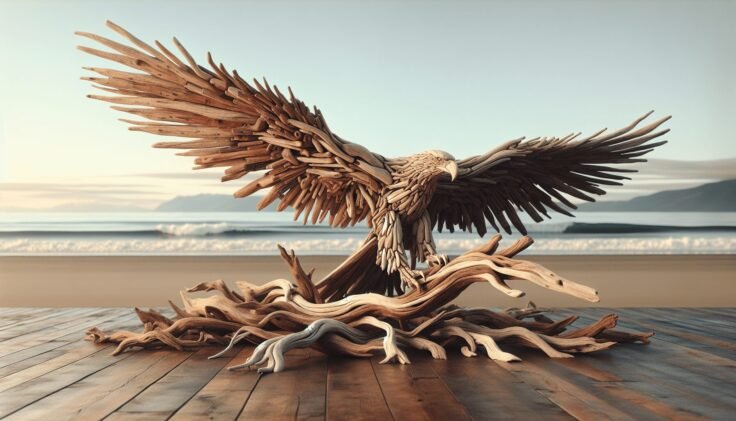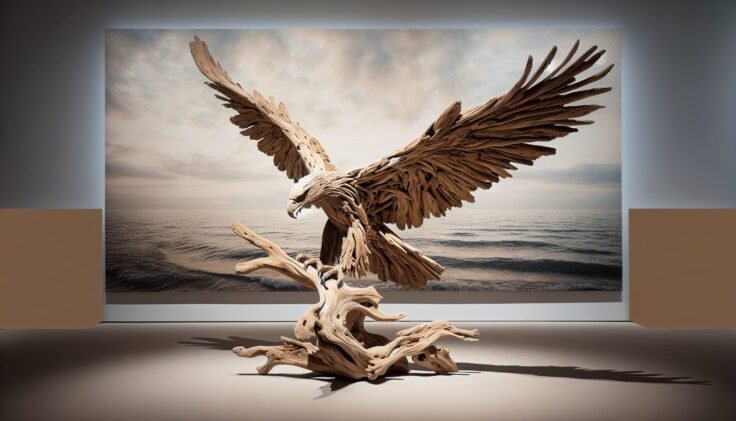Have you ever marvelled at how nature’s remnants can be transformed into breathtaking art? If not, the world of driftwood eagle sculptures may just ignite your imagination. These stunning creations not only capture the majestic essence of eagles but also highlight the beauty of recycled natural materials. So, let’s journey through the fascinating process of creating these sculptures, the skills involved, and the unique appeal they hold for artists and admirers alike.
The Enchantment of Driftwood
Driftwood is wood that has been washed onto a shore or beach of a sea, river, or lake by the action of winds, tides, or waves. It is often praised for its organic beauty and the way it embodies nature’s artistry, with each piece having its own unique character shaped by the elements. As it’s worn smooth by nature, there’s a softness in its appearance that appeals to the senses.
What Makes Driftwood Special?
Driftwood is celebrated for its distinct characteristics such as varied textures, unpredictable forms, and often intriguing shapes. These characteristics provide a canvas for artists, allowing the wood itself to inspire the final sculpture. Each piece of driftwood tells a story of its journey—whether it’s a storm-tossed branch that has travelled thousands of miles or a tree root from a nearby riverbank.
Benefits of Using Driftwood
Using driftwood in art promotes sustainable practices by recycling natural waste into valuable artistic expressions. Additionally, working with driftwood encourages appreciation for natural processes and the environments from which these works originate. Artists often find a sense of satisfaction in giving a new purpose to something nature intended to discard.
The Art of Sculpting with Driftwood
The process of creating a sculpture from driftwood requires a great deal of creativity, skill, and patience. Artists often rely on the natural shapes and curves of driftwood to inspire the direction of their work, rather than forcing the wood into predetermined forms.
Essential Skills for Driftwood Sculpting
While no formal training is strictly necessary to begin creating driftwood sculptures, certain skills can greatly enhance the process:
- Visual Imagination: The ability to visualize potential shapes within irregular pieces of wood is crucial.
- Patience and Precision: Driftwood sculpting can be delicate work, requiring patience and an eye for detail to piece sections together seamlessly.
- Craftsmanship: Basic woodworking skills can be very beneficial, including knowledge of tools like saws, sanders, and chisels.
Common Tools and Materials
Though each artist may have a preferred set of tools, some essentials include:
| Tool | Purpose |
|---|---|
| Saw | Cutting larger pieces of driftwood |
| Sandpaper | Smoothing edges and surfaces |
| Chisels | Shaping finer details |
| Wood glue | Assembling different pieces securely |
| Wire and Nails | Reinforcing connections |
Additional elements like paint, varnish, or stains may also be used to enhance the sculpture’s appearance or increase its durability.

Crafting a Driftwood Eagle Sculpture
Creating a driftwood eagle sculpture involves more than simply assembling pieces of wood into an avian shape. The artist must capture the spirit and grace of the eagle, a symbol of freedom and strength, through careful selection and placement of each fragment.
The Creative Process
1. Selecting Your Driftwood
The first step involves gathering driftwood pieces that complement each other in shape, size, and color. Consideration is given not only to the final form but also to how each piece can contribute to the overall texture and balance. Finding the right wood can be a meditative process, often taking place along various waterlines where nature has unveiled its latest treasures.
2. Visualizing the Eagle
Envision the eagle poised in mid-flight or perched proudly. Do you see its powerful wings, sharp beak, and keen eyes? This mental image will guide the assembly of your sculpture.
3. Building the Structure
Begin by forming the basic framework. The torso often forms the centerpiece, with wings and tail carefully crafted to add balance. The wood is cleverly selected and positioned so the natural curves and grains suggest the intended shapes and movements.
4. Detailing and Refinements
With the primary structure in place, it’s time to bring your eagle to life. Fine details such as feathers, claws, and facial features are meticulously added. Tools like chisels offer precision, while sandpaper ensures a smooth finish. Each tiny adjustment contributes to a realistic portrayal of the eagle’s majesty.
5. Finishing Touches
Decide whether to leave the sculpture in its natural state or add finishing touches such as varnish to protect the wood and enhance its color. Some artists choose to accent features with paint to draw attention to specific details or effects.
The Appeal of Driftwood Eagle Sculptures
Driftwood eagle sculptures have a universal appeal that resonates with art collectors, environmentalists, and nature lovers alike. Their aesthetic appeal lies not only in their appearance but also in the deeper connections they foster between humans and nature.
Aesthetic Beauty and Symbolism
Eagles represent strength, freedom, and vision. Translating these qualities into a sculpture using natural materials adds depth to their artistic value. The beauty of driftwood works synergistically with the noble image of the eagle, offering both a visual and symbolic experience.
Environmental and Cultural Significance
As artworks created from naturally found materials, these sculptures promote sustainability and environmental awareness. Each piece encourages the appreciation of nature where art and ecology intersect. Furthermore, as cultural symbols, eagles arouse a sense of national pride and respect across various societies, enhancing the sculpture’s resonance and value.
Driftwood Sculptures in Modern Art
In contemporary art, driftwood sculptures are celebrated for their innovation and environmental consciousness. More artists continue to embrace these practices, bringing diverse interpretations and techniques to the table, thus expanding the boundaries of traditional sculpture.

Honoring the Craft Through Workshops and Exhibitions
Workshops can provide aspiring artists valuable insights into the nuanced craft of driftwood sculptures, offering hands-on experiences under seasoned professionals. Learn about professional techniques, gain feedback on your approach, and connect with a community that shares your passion for turning natural remnants into wondrous art.
Participating in Driftwood Workshops
Workshops cover a range of topics, from the basics of selecting driftwood to advanced sculpting techniques. Beyond technical skills, they inspire camaraderie among participants, fostering an environment where creativity and ideas flourish.
Exhibitions and Galleries
Numerous art galleries and exhibitions worldwide celebrate driftwood sculptures, providing a stage for showcasing these unique works. Here, artists receive recognition while audiences are introduced to the artistry and thoughtfulness behind each sculpture. Exhibitions can also inspire future generations to continue exploring artistic possibilities found in nature.
Conclusion
Driftwood eagle sculptures offer a harmonious blend of nature’s raw beauty with human creativity, standing as exquisite reminders of the bond between our environments and artistic expression. As you consider how natural materials can be transformed into symbols of strength, freedom, and artistry, the fascinating world of driftwood awaits your discovery. Through the inspired hands of sculptors, these wood fragments soar once more, much like the eagles they embody, inviting us to appreciate both form and meaning in the intricacies they present. Whether you’re an artist, collector, or a nature enthusiast, there’s an aspect of driftwood eagle sculptures that will certainly captivate your heart and feed your imagination.
























